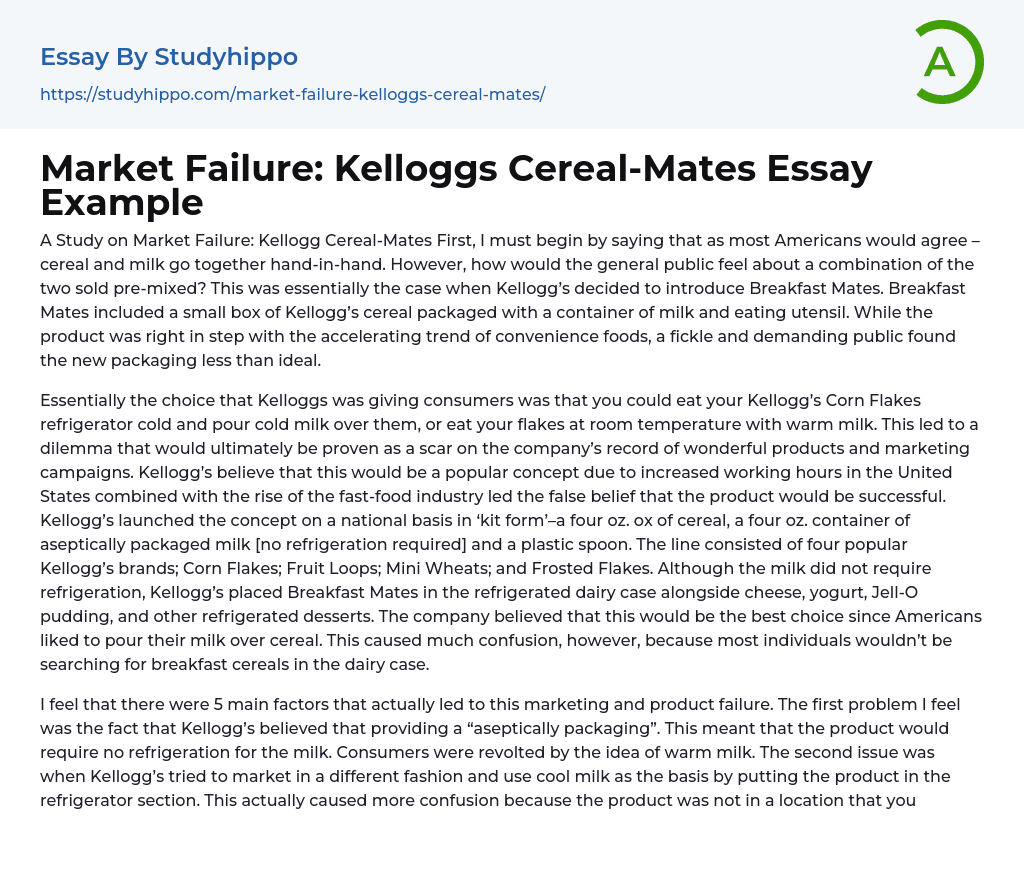
A Study on Market Failure: Kellogg Cereal-Mates First, I must begin by saying that as most Americans would agree – cereal and milk go together hand-in-hand. However, how would the general public feel about a combination of the two sold pre-mixed? This was essentially the case when Kellogg’s decided to introduce Breakfast Mates. Breakfast Mates included a small box of Kellogg’s cereal packaged with a container of milk and eating utensil. While the product was right in step with the accelerating trend of convenience foods, a fickle and demanding public found the new packaging less than ideal.
Essentially the choice that Kelloggs was giving consumers was that you could eat your Kellogg’s Corn Flakes refrigerator cold and pour cold milk over them, or eat your flakes at room temperature with warm milk. This led to a dilemma that w
...ould ultimately be proven as a scar on the company’s record of wonderful products and marketing campaigns. Kellogg’s believe that this would be a popular concept due to increased working hours in the United States combined with the rise of the fast-food industry led the false belief that the product would be successful. Kellogg’s launched the concept on a national basis in ‘kit form’–a four oz. ox of cereal, a four oz. container of aseptically packaged milk [no refrigeration required] and a plastic spoon. The line consisted of four popular Kellogg’s brands; Corn Flakes; Fruit Loops; Mini Wheats; and Frosted Flakes. Although the milk did not require refrigeration, Kellogg’s placed Breakfast Mates in the refrigerated dairy case alongside cheese, yogurt, Jell-O pudding, and other refrigerated desserts. The company believed that this would be the best choice
since Americans liked to pour their milk over cereal. This caused much confusion, however, because most individuals wouldn’t be searching for breakfast cereals in the dairy case.
I feel that there were 5 main factors that actually led to this marketing and product failure. The first problem I feel was the fact that Kellogg’s believed that providing a “aseptically packaging”. This meant that the product would require no refrigeration for the milk. Consumers were revolted by the idea of warm milk. The second issue was when Kellogg’s tried to market in a different fashion and use cool milk as the basis by putting the product in the refrigerator section. This actually caused more confusion because the product was not in a location that you would expect cereal at.
They company spent too much of what profit money they had received in trying to re-educate consumers into looking in the dairy aisle for cereal. The third factor that led to the products unsuccessful stint into the marketplace was their advertising campaign. In these ads Kelloggs chose to market the product to young kids so they could prepare meals for themselves without their parents’ help. This would have been fine, but the packaging was not child-friendly. Taste was also a serious problem for the Kellogg’s convenience line. Reportedly (according to personal experience), the milk was usually consumed at work or away from home.
The warm milk tasted absolutely terrible. Finally, the biggest nail in the coffin for this product was that the price. The cereal was selling for over one dollar per serving, which was considered too expensive by most consumers for a 4
oz cereal. The product survived two years on the market before Kelloggs’ pulled the plug. According to the February 2000 article in the Newsweek on the food, they stated that the product simply wasn’t convenient enough. This is because with increased commute times and busy schedules people wanted a product they could eat on the go.
With cereal mates they were required to still pour a liquid milk over the cereal which was not possible to do safely while commuting to work. Most customers also were adults, so the small spoon that was supplied with the cereal was too hard to use. I feel that this was a good product in concept, but the complexity of the concept made this product non-attractive to those who not only were needing a convenient and healthy food, but also one they could consume in a hurry. This idea later evolved to the milk and cereal bars they would later introduce around 2004 – which have been wildly more successful than the original cereal mates ever were.
- Food Safety essays
- Food Security essays
- Beverages essays
- Cuisines essays
- Dairy essays
- Desserts essays
- Fast Food essays
- Bread essays
- Meal essays
- Meat essays
- Organic Food essays
- Rice essays
- Sugar essays
- Taste essays
- Beef essays
- Coconut essays
- Crowd essays
- Dinner essays
- Juice essays
- Sainsbury essays
- Cooking essays
- Ginger essays
- Oreo essays
- Drink essays
- Beer essays
- Wine essays
- Coffee essays
- Tea essays
- Cake essays
- Hamburger essays
- Ice Cream essays
- Burger essays
- Pizza essays
- Fruit essays
- Lemon essays
- Food Waste essays
- Favorite Food essays
- Alcoholic essays
- Soft Drinks essays
- Cookie essays
- Starch essays
- Yeast essays
- Cola essays
- Pizza Hut essays
- snack foods essays
- chips essays
- Biscuit essays
- Brewing essays
- Brewery essays
- Advertising essays



